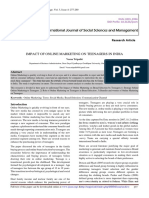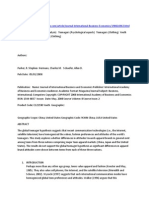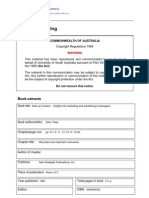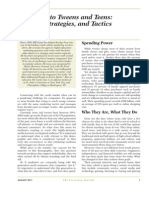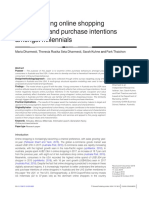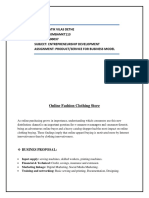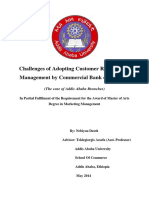Market segmentation has been defined as process of dividing a market into
meaningful, relatively similar, and identifiable segments or groups. Global market
segmentation is the process of identifying segments whether they be country groups
or individual buyer groups, of potential customers with homogeneous attributes who
share similar needs and buying behaviour patterns. Targeting Marketing is the process
of evaluating the segments and focusing marketing efforts on a country, region, or
group of people that has significant potential to respond. Such targeting reflects the
reality that a company should identify those consumers it can reach most effectively,
efficiently, and profitably.
Individual from age 12-19 years are teenagers. They are independent of parents in
order to identify their self-image. Normally they are influenced by brand names,
entertainment, trendy products. Teens usually shared interests and characteristics with
friend.
�Global teenage market segmentation is a generalization of the stereotype of teens who like to
share similar interest in music, fashion, film, video games and technology. They trying to
emulate other cultures to reach self-satisfaction and increase self-confidence. Nowadays, we
can see global teenage boys will spend most of their money and time on dating, movie,
entertainment, games, foods. It is totally different for Global teenage girl. Mostly will spend
their money on apparel, fragrances, comestics, jewelry, shoe, bag. It is agreed that the desire
to be beautiful or handsome, healthy and free of pain is a universal aspect. Teenagers all over
the world share similar characteristics and hobbies, which makes the market segmentation
active and makes the market bullish on global firms . “Diesel Jeans, Coca-Cola, Swatch,
Sony, Nike, SHEIN, Revolve, Princess Polly and other companies are pursing the global
teenage segment”. The global telecommunications revolution is a critical driving force
behind the emergence of this segment. Female teenagers bought twice as much as clothing as
male teens. Male teenagers bought three times more video games than female. African
Americans spend 6% more than average teenagers on clothing, computer software, athletic
footwear, and music (Davis, 2011)
Teenage market also
Emerging markets (eg, India,Brazil, Thailand) having 50% plus of the population under Age
25, this placed these countries on the A-list for almost all global firms. The important things
for a teenager’s life relationship with family accomplishments as much as possible and have
fun time together. Relationship with friends making the world better place and being accepted
as an individual. Teenagers are divided into four attitudinal market segments. That will be
socially driven, diversely motivated, socially introverted and sport oriented. Under these 4
market segment, teenagers may interests in clothing, brand conscious, interests in cultural
products, books music, magazines etc. Also interests in electronic product and interests in
sports related activities.
We can see that it’s true that teens all over the world are sharing certain interests. Example
like healthy, beautiful, fashionable, and etc. Teen’s tastes are different from one country to
another especially in culture, preferences, behaviours and way of thinking. With these are
enough to drive the global market to seek for adaptation when targeting teenagers.
Everything is being adapted to suit the teenagers tastes. Examples : Coca-Cola has propelled
a unused TV campaign, "See Up", to centre on Thai youngsters that cantered on rousing
youth to effectively "go for it”, “Look Up" commercials emphasize an inventive thought
related to the way of 4 life of youngsters, additionally empowers them to accept in themselves
and their capacity to overcome troubles and deterrents when taking after their dreams. (Okan
Akcay, 2012)
Teenager under this age have strong buying power. They are the most multi-culturally diverse
group of consumers. The teenage market has become a very important consumer segment in
the U.S. and global markets (Kotler and Keller, 2011). The teenage population is growing at
twice the rate of the overall U.S. population. The number of American teenagers is over 32
million (Cohen, 2009). Globally, the number of teenagers is 1.3 billion (Keegan and Green,
2013). Teenagers spend their free time by doing a variety of activities including shopping
online, social media, technology, listening to music, sports and watching TV. Teens are
�realistic and quick to adopt new trends, and both male and female teenagers spend most of
their money on clothes (D’Souza, 2010)
However, China population 1.3 billion and become the largest consumer segment in the
world. Tees population is about 200 million. Before year 2016, china has enforced one
child policy so parents will spend about 66% of combined income on child. Estimated
annual teen spend is about US$36 billion, from sources such as pocket
money,food,schooling, clothing and etc. 64% of teens feel it is important to be up to date
with fashion trends, with 19% of teens desiring named brands. 88% of Chinese teens
trust local brands, while 64% trust foreigner brands. Teenagers spend a lot of time surf
net, hanphone for games and social media. In contrast to their taste, they tend to look for
Japan rather than West for their foreign pop idols.
Many of the traditional values are still available, some would debate concerning matters that
U.S teenagers may differ towards Asian Teenagers.
The below is Hofstede’s Cultural Dimensions of both U.S and Asian Teenagers. With these
analyses, marketers can design their products in accordance to suit the needs of both U.S. and
Asian teenager. (Vasileva, 2015)
Hofstede’s Cultural USA Teenagers Asian Teenagers
Dimension
Power Distance Low High
More tricky to influence and Inclined by tradition
control
Uncertainty Avoidance Low High
Want to be and seek to Less rebellious. Likely to
independent from home stay at home until married
Individualism Individualistic Collectivistic
Since childhood learn to Raised to have group
think of themselves first mentality
Companies always thinking of only adults have purchasing power, the habits of
teenagers are often forgotten. But the truth is teenagers are buying, just differently way.
Traditionally marketing to teenagers started by thinking about the basic demographics of
the teenage audience. These included gender,race,age,religion and location. Instead of
defining teens by their gender or socioeconomic status, you should start grouping teens
using behavior. Trends in teen are using websites and apps now. Many of them like to
be sharing information via social media. YouTube, Instagram and Snapchat are the most
popular online platforms among teens. Fully 95% of teens have access to a smartphone,
and 45% say they are online 'almost constantly’ teenagers can be smart consumers of
media messages. They don’t just take in everything they see and hear on social media
or in other media. Now a days, every age group is actively using social networking sites. But
the most popular segment on social networking sites is the group of teenagers. They not only
share their every moment of life on these sites but also showcase their interests in several other
fields like sports, music, clothing etc
The convenience of online is quickly evolving in front of our eyes and has been the crucial part in
current era. This enhances the purchasing power of teenagers. The paper discussed the role of
�teenagers in the family buying process and online brand selection by teenagers. The researcher
believes the importance of understanding the characteristics and International Journal of 360
Management Review, Vol. 07, Issue 04, January 2020, ISSN: 2320-7132 16 buying process of
teenagers before drawing their role in online marketing. Teenagers are playing a very crucial role in
family buying process as they are tech savvy consumers. As the data captured by Data monitor in
2007, $1.2 trillion has been counted as men’s, women’s and infants clothing, jewellery, watches and
leather goods in the global market. Among this 47.5 percent has been marked as women wear while
31.9 percent as men wear. Teenagers are forming a new relation with the new media and made
them more tech -savvy.
Other than that, we believed Colour also be an important feature and characteristic that influences
teen’s product choices. Research shows that there is a difference in colour choices for various
products based on teen’s gender and or ethnicity. For marketing to teens to be most effective,
companies must be clear about who their target market is and tailor their products with respect to
colour. Below chart show popular products frequently purchased and used by teenagers.
Table : Overall Ethnic Teenagers Product Colour Choice
Female Male
Clothing Black 20.22% Red 27.73%
Other 16.85% Black 23.53%
Blue 16.85% Blue 22.69%
Female Male
Cellphone Black 37.08% Red 9.17%
Other 14.61% Blue 10.83%
Blue 14.61% Black 67.50%
Female Male
Shoe Black 38.20% Black 40.83%
White 30.34% White 21.67%
Other 17.98% Red 18.33%
Overall, black is the product colour choice among all female and male teenagers of the
different ethnicities surveyed for selected products.
�http://courseweb.glendale.edu/poorna/keegan_7.htm
cutehalle, 2013. Teenage Segmentation Final. Teenager, 18 May.
https://www.renolon.com/teenage-spending-statistics/
https://www.slideshare.net/cutehalle/teenage-segmentation-final
Okan Akcay, D., 2012. Marketing to Teenagers: The influence of Color, Ethnicity and
Gender. [Online]
St.-Maurice & Wu,2006 Parker,Et al.2004
http://ijbssnet.com/journals/Vol_3_No_22_Special_Issue_November_2012/2.
pdf [Accessed 20 August 2018].
https://www.outbrain.com/help/advertisers/content-marketing-to-teenagers/
https://www.pewresearch.org/internet/2018/05/31/teens-social-media-technology-2018/
International Journal of 360 Management Review, Vol. 07, Issue 04, January 2020, ISSN: 2320-7132
Grossman, R. P. and Wisenblit J. Z. (1999), What we know about consumers’ color choices,Journal of
Marketing Practice , 5 (3), pp. 78-90.



